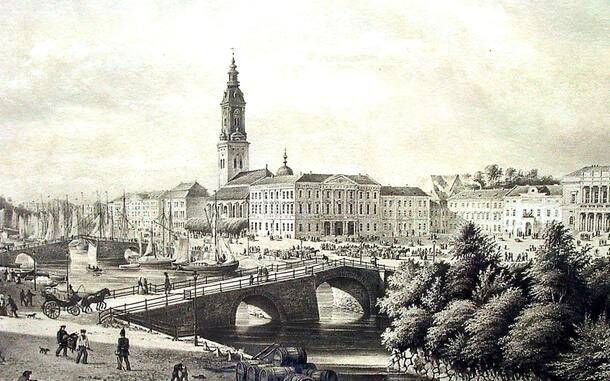
19th century

During the 19th century, Sweden’s export industry developed rapidly, and volumes in the port increased. The number of ships grew, and they became larger, able to navigate more efficiently thanks to steam power. It was during this period that the port’s first quay for ocean-going vessels was built.
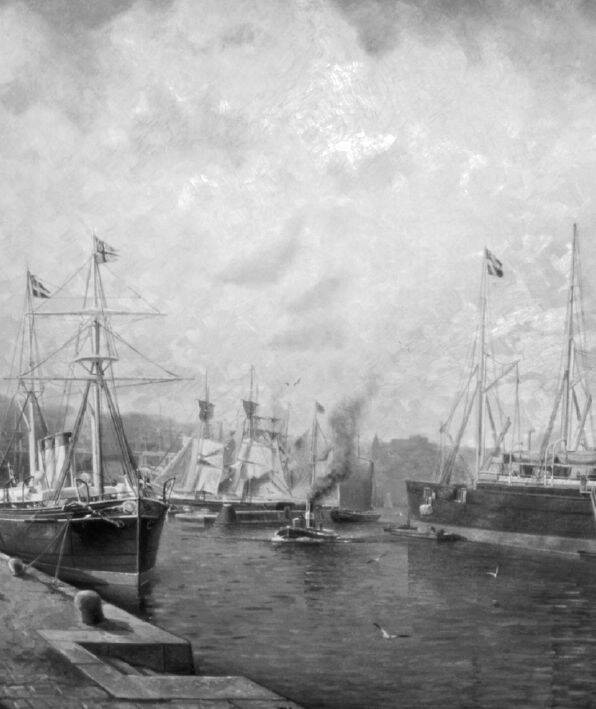
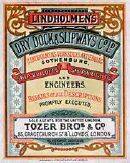
THE GREAT HARBOUR
The Great Harbour as seen from Brunnsparken in 1850.
GULLBERG QUAY
Between 1845 and 1872, quays were constructed from Skeppsbro Quay in the west to Gullberg Quay in the east.
THE SHIPBUILDING
INDUSTRY TAKES OFF
In the 19th century, several mechanical workshops were established in Gothenburg. Over time, they developed into some of Sweden's largest shipyards.
ROSENLUND CANAL
Feskekôrka was built on reclaimed fortification land and was inaugurated on November 1, 1874. The image is from around 1900.
STENPIREN AND SKEPPSBRO QUAY
In the mid-19th century, Stenpiren was completed, and a few years later, Skeppsbro Quay was built, becoming a popular promenade.
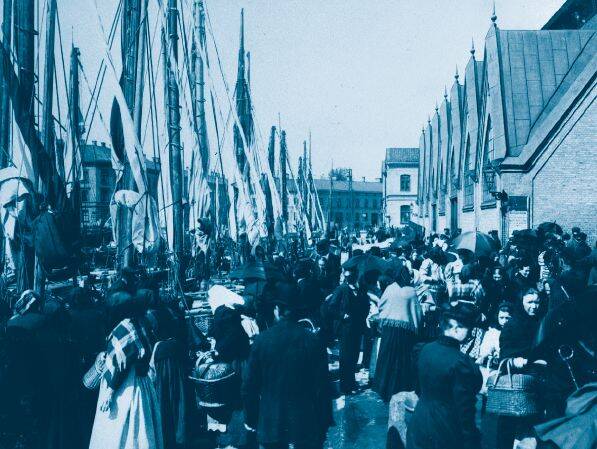
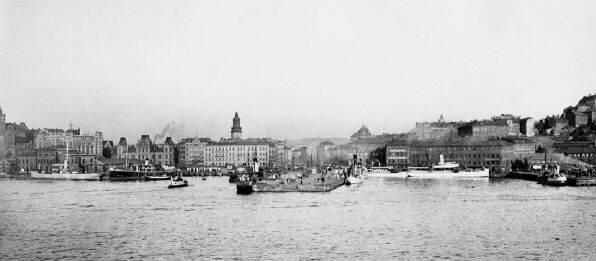
In the mid-19th century, ships had grown larger and, thanks to steam power, had better access to navigate up the Göta River. This made it necessary to construct quays along the river. The first modern river quay, Stenpiren, was completed in 1845.
Skeppsbro Quay was built in 1864 and soon became a popular promenade. The Bathhouse, considered the finest public bath in the country, was also located here. Built in 1830, it offered both fresh and saltwater baths. Every day, a steamboat would travel to Känsö in Gothenburg's southern archipelago to fetch seaweed and fresh seawater.
ERIKSBERG
One of Sweden’s largest shipyards took its first steps with various galvanization works. Eriksbergs Mekaniska Verkstads AB was founded in 1850 and established a shipyard adjacent to the workshop in 1871. Until the 1910s, it was the smallest of the three Gothenburg shipyards. Production mainly consisted of passenger boats, steam launches, and tugboats for Denmark, Norway, and Finland, as well as archipelago boats for Stockholm. Eriksberg’s growth into a major shipyard began in 1915 when shipping magnate Dan Broström acquired a majority stake in the company.
During the 1950s and 1960s, Eriksberg was the most profitable shipyard in the country, but by the late 1960s, competition from the Japanese shipbuilding industry became increasingly intense. The situation worsened during the shipyard crisis of the 1970s, and in 1975, the yard was taken over by the state. Eriksberg became a subsidiary of Götaverken before its closure in 1979.
As part of the redevelopment of the Northern Riverbank, Eriksberg has since transformed into a residential area. The large gantry crane remains as a landmark from its shipbuilding era. Other preserved historical buildings include Juvelkvarnen and Eriksbergshallen.
The first river quay and the first shipyard
The Flow of Emigrants to the USA
During the first half of the 19th century, Gothenburg was the most common departure city for Swedish emigrants.
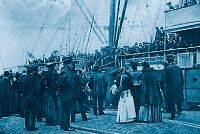

THE INDUSTRIAL ERA AND THE PORT
Construction of the current port began in the 1840s, with dredging around Stora Bommen. Between 1845 and 1872, quays were built, later modernized, stretching from Skeppsbro Quay in the west to Gullberg Quay in the east. Increased traffic, driven by steamships and the opening of the Göta Canal in 1832, created the need for a larger and deeper port.
In the latter half of the 19th century, Sweden’s export industry expanded rapidly, increasing the port's volume. Between 1888 and 1902, Masthugg Quay, the port’s first quay for ocean-going ships, was constructed. The approach channel was dredged to a depth of seven meters, and railway tracks were added along the quays. Gothenburg’s port began to grow into a major harbor.
THE ERA OF EMIGRATION
Initially, the flow of Swedish emigrants to the USA was fairly limited. In the first half of the 19th century, direct voyages by sailing ships were the norm, and Gothenburg was the most common departure point. For example, travelers could reach New York on the brig Superb. At this time, Sillgatan (later renamed Postgatan) was a bustling street where emigrants could purchase tickets and find cheap, though cramped, accommodation while awaiting departure.
The number of emigrants surged in the early 1850s with the discovery of gold in California. From the late 1860s onward, it became common to travel from Gothenburg via England, first by ship to Hull, then by train to Liverpool, and onward across the Atlantic. Hamburg was another departure option. The main line between Gothenburg and Hull was the Wilson Line, which had agreements with transatlantic lines in England to coordinate emigrant traffic from Scandinavia. In 1870, the line introduced two specially built ships, Orlando and Rollo. By this time, ships were departing from Packhuskajen instead of Klippan.
The emigration wave peaked in the 1880s, bringing larger ships and increased frequency. For example, in 1904, Calypso, the largest passenger steamer on the North Sea at the time, was introduced on the route between Gothenburg and Hull, England.
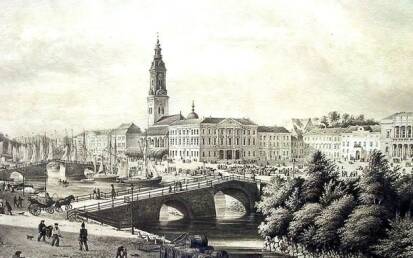
THE GREAT HARBOUR
The Great Harbour as seen from Brunnsparken in 1850.
GULLBERG QUAY
Between 1845 and 1872, quays were constructed from Skeppsbro Quay in the west to Gullberg Quay in the east.
THE SHIPBUILDING
INDUSTRY TAKES OFF
In the 19th century, several mechanical workshops were established in Gothenburg. Over time, they developed into some of Sweden's largest shipyards.
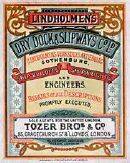
19th century
During the 19th century, Sweden’s export industry developed rapidly, and volumes in the port increased. The number of ships grew, and they became larger, able to navigate more efficiently thanks to steam power. It was during this period that the port’s first quay for ocean-going vessels was built.

In the mid-19th century, ships had grown larger and, thanks to steam power, had better access to navigate up the Göta River. This made it necessary to construct quays along the river. The first modern river quay, Stenpiren, was completed in 1845.
Skeppsbro Quay was built in 1864 and soon became a popular promenade. The Bathhouse, considered the finest public bath in the country, was also located here. Built in 1830, it offered both fresh and saltwater baths. Every day, a steamboat would travel to Känsö in Gothenburg's southern archipelago to fetch seaweed and fresh seawater.
ERIKSBERG
One of Sweden’s largest shipyards took its first steps with various galvanization works. Eriksbergs Mekaniska Verkstads AB was founded in 1850 and established a shipyard adjacent to the workshop in 1871. Until the 1910s, it was the smallest of the three Gothenburg shipyards. Production mainly consisted of passenger boats, steam launches, and tugboats for Denmark, Norway, and Finland, as well as archipelago boats for Stockholm. Eriksberg’s growth into a major shipyard began in 1915 when shipping magnate Dan Broström acquired a majority stake in the company.
During the 1950s and 1960s, Eriksberg was the most profitable shipyard in the country, but by the late 1960s, competition from the Japanese shipbuilding industry became increasingly intense. The situation worsened during the shipyard crisis of the 1970s, and in 1975, the yard was taken over by the state. Eriksberg became a subsidiary of Götaverken before its closure in 1979.
As part of the redevelopment of the Northern Riverbank, Eriksberg has since transformed into a residential area. The large gantry crane remains as a landmark from its shipbuilding era. Other preserved historical buildings include Juvelkvarnen and Eriksbergshallen.
The first river quay and the first shipyard
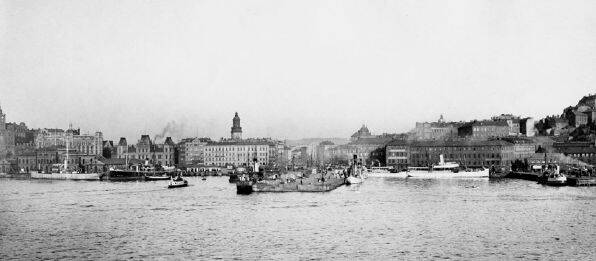
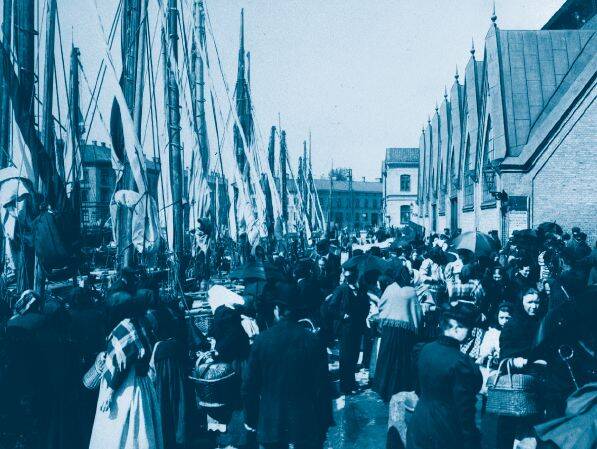
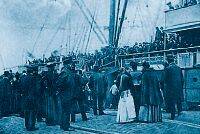
The Flow of Emigrants to the USA
During the first half of the 19th century, Gothenburg was the most common departure city for Swedish emigrants.
THE INDUSTRIAL ERA AND THE PORT
Construction of the current port began in the 1840s, with dredging around Stora Bommen. Between 1845 and 1872, quays were built, later modernized, stretching from Skeppsbro Quay in the west to Gullberg Quay in the east. Increased traffic, driven by steamships and the opening of the Göta Canal in 1832, created the need for a larger and deeper port.
In the latter half of the 19th century, Sweden’s export industry expanded rapidly, increasing the port's volume. Between 1888 and 1902, Masthugg Quay, the port’s first quay for ocean-going ships, was constructed. The approach channel was dredged to a depth of seven meters, and railway tracks were added along the quays. Gothenburg’s port began to grow into a major harbor.
THE ERA OF EMIGRATION
Initially, the flow of Swedish emigrants to the USA was fairly limited. In the first half of the 19th century, direct voyages by sailing ships were the norm, and Gothenburg was the most common departure point. For example, travelers could reach New York on the brig Superb. At this time, Sillgatan (later renamed Postgatan) was a bustling street where emigrants could purchase tickets and find cheap, though cramped, accommodation while awaiting departure.
The number of emigrants surged in the early 1850s with the discovery of gold in California. From the late 1860s onward, it became common to travel from Gothenburg via England, first by ship to Hull, then by train to Liverpool, and onward across the Atlantic. Hamburg was another departure option. The main line between Gothenburg and Hull was the Wilson Line, which had agreements with transatlantic lines in England to coordinate emigrant traffic from Scandinavia. In 1870, the line introduced two specially built ships, Orlando and Rollo. By this time, ships were departing from Packhuskajen instead of Klippan.
The emigration wave peaked in the 1880s, bringing larger ships and increased frequency. For example, in 1904, Calypso, the largest passenger steamer on the North Sea at the time, was introduced on the route between Gothenburg and Hull, England.
